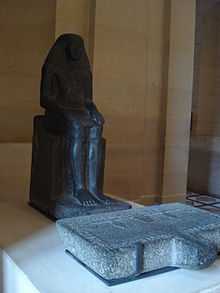Hotep
| ||
| ḥtp ('hotep', 'hetep') in hieroglyphs |
|---|

The Egyptian word Hotep (ḥtp) translates to roughly "to be satisfied, at peace". It is regularly found in the names of ancient Egyptian figures such as Hotepsekhemwy (ḥr ḥtp-sḫm.wj "the two powers are at peace"), the first ruler of Egypt's Second Dynasty.[1] It is rendered in hieroglyphs as an altar/offering table (Gardiner R4). It has special semantic meanings in the Ancient Egyptian offering formula, also known as the ḥtp-dỉ-nsw formula, to refer to the "boon given by the king," or the food and goods on which a dead soul was supposed to subsist during the afterlife.[2]
Hotep is the Egyptological pronunciation of Egyptian ḥtp (Gardiner p 579 and 617 = law). The phrase m hotep has been translated to mean literally from law "peace" (Gardiner p 583 and 620 "to rest" "be satisfied", "peace", "become at peace" and "at ease") as in the Egyptian philosophy of living the life in Maat.[3][4][5]
Pharaonic names with 'hotep'
Names of pharaohs using "hotep":
- Hotepsekhemwy, Mentuhotep I, Nebhetepre Mentuhotep II, Sankhkare Mentuhotep III, Nebtawyre Mentuhotep IV, Sehetepibre Amenemhat I, Sehetepre, Kaankhre Sobekhotep I, Sekhemresewadjtawy Sobekhotep III, Khasekhemre Neferhotep I, Khaneferre Sobekhotep IV, Khahotepre Sobekhotep V, Merhotepre Ini, Mentuhotep V, Sobekhotep VIII, Neferhotep III, Mentuhotep VI, Rahotep, Djeserkare Amenhotep I, Aakheperrure Amenhotep II, Nebmaatre Amenhotep III; (last of 'peace, content' use, 18th Dynasty, (14th century BC, Amarna letters correspondence century))
In popular culture
- Nyarlathotep is a deity or a demon in stories by H.P. Lovecraft.
- In the film Bubba Ho-tep, the title is a nickname for a reanimated mummy that wears a cowboy hat.
- An avatar is available in Active Worlds named Hotep.
- One of the advisors to Pharaoh in The Prince of Egypt is named Hotep.
- "Hotep" is a commonly used greeting in Afrocentric circles.[6][7]
See also
- Radical 113 - A similar glyph in Chinese
- List of hieroglyphs/R
References
- Faulkner (Middle Egyptian, 1991 Griffith ISBN 0-900416-32-7) has:
p 159 hrt = "peace", hrw = "pleasing, be pleased, satisfied";
p 179 htp = "altar, offering, boon which the king grants, be pleased, be happy, be gracious, pardon, be at peace, be peaceful, become calm"
p 180 "rest, satisfy, make content, htpw peace, contentment, good pleasure, make peace, htpt peace, contentment. To put to rest disputes, and settle the complaints of petitioners be peaceful, calm, make peace".
Notes
- ↑ "Egyptian kings - Hotepsekhemwy, Hetepsekhemwy, Bedjau, Boethos". nemo.nu.
- ↑ Gardiner, Alan. (1957). Egyptian Grammar, Third Edition, p. 170. Griffith Institute, Ashmolean Museum, Oxford. ISBN 0-900416-35-1.
- ↑ "NiankhkhnumKhnumhotep Names United". egyptology.com.
- ↑ Branney, Sean (1988). Strange Eons (PDF). 2, Issue 10. Retrieved July 16, 2006.
- ↑ http://www.ancient-egypt.org/kings/02/0201_hotepsekhemwi/titulary.html
- ↑
- ↑ Rudy Aunk (2007-11-29). "The Cultural Health News Blog: What is the Meaning of Hotep?". Culturalhealth.blogspot.com. Retrieved 2014-07-31.
External links
| Wikimedia Commons has media related to Hotep (hieroglyphs). |